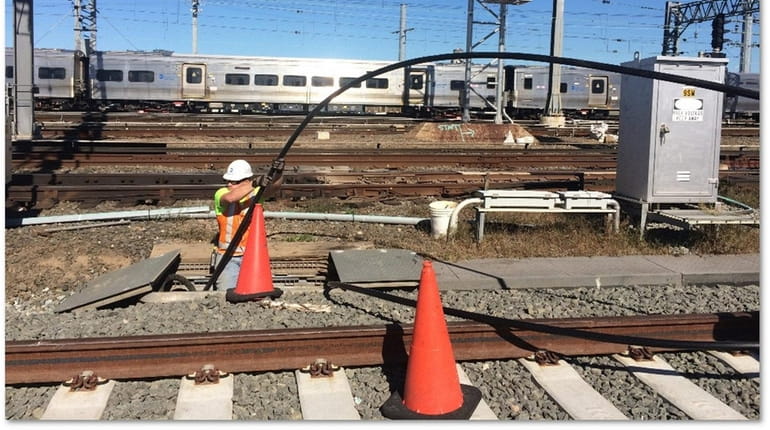MTA is stuck in its old ways

LIRR installs the inner duct of a conduit that will house fiber optic cable which will control the electrically operated switches for the Harold Interlocking rail junction, Oct. 19, 2017. Credit: NYMTACC
The Long Island Rail Road’s day-to-day delays and other operational troubles, which in January resulted in the worst on-time performance in 22 years, are emblematic of far larger institutional troubles that plague the Metropolitan Transportation Authority.
Take the massively behind-schedule, costly quagmire known as East Side Access.
It’s the story of how not to do a major transportation project. It’s a tale of mismanagement and miscommunication above and below ground. In its saga are many lessons, and an opportunity to make significant changes in how our transportation agencies think about, plan, pay for and execute massive capital improvements. These are culture changes that could improve the day-to-day commute as well.
To be clear: The effort to extend the Long Island Rail Road to Grand Central Terminal is a critically important one that will benefit tens of thousands of commuters. When it’s done, it will provide a path to the East Side, redundancy for commuters, and an all-important alternative to the decrepit and crowded halls of Penn Station. It will save commuting time and increase capacity. And a one-seat commute to the East Side of Manhattan will make Long Island’s real estate market more attractive.
But a recent report from the Regional Plan Association details the dark, dingy reality beneath the bright and shiny goals. East Side Access has been the definition of a project with ballooning costs and constant delays. The MTA originally projected the link would be done in 2009 at a cost of $4.3 billion; it’s now estimated to cost $12 billion and be completed in 2022. The various players — Amtrak, the MTA, its individual agencies and MTA Capital Construction — have been unable to finish the work. It’s been a tale of change order after change order, inefficient work rules and constant missteps.
Little has been done right. So, the MTA has to overhaul how it handles larger capital projects. That means providing more realistic timeframes and budget estimates, finding ways to make environmental reviews more efficient and expeditious, talking with communities earlier and often, and using design-build processes to develop and finish projects.
It also means a sweeping change to the silos within the MTA. For too long, the LIRR, Metro-North and New York City Transit haven’t communicated well, shared equipment or resources, or coordinated when projects overlap. Reorganize the authority so it operates in a streamlined, sensible manner. Allow people of similar skills and experience to work together more easily. Make sure equipment is uniform so it can be shared. And develop a leadership structure for each project that can prevent turf wars or communication breakdowns.
MTA Capital Construction needs reform. It lacks authority or accountability even while it’s supposed to manage big projects. It’s worth considering the Regional Plan Association’s suggestions on finding alternative ways to manage and finance big projects to make sure all the players and pieces of a single big effort pull together, that money flows and is spent properly, that delays and overruns end.
Find a way to run the trains — and the capital projects — on time and on budget.
